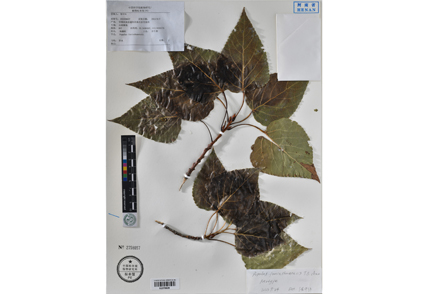Abstract
The article typified thirteen names of Chinese poplars which published by Zhao Tian-Bang or together with his cooperator in 1978 and 1980. By examining specimens preserved at PE, KUN, WUK, CAF, and HEAC, communication with Zhao Tian-Bang, we found that the original materials of Populus honanensis, P. funiushanensis, P. celtidifolia, P. davidiana var. lyshehensis, P. adenopoda var. nanchaoensis, P. adenopoda var. rotundifolia, P. hopeiensis var. ovatifolia, P. hopeiensis var. flavida, P. sunghoensis, P. davidiana var. longipetiolata, P. yunsiaoshanensis, and P. adenopoda var. microphylla were lost, and there was only one illustration left for P. tomentosa var. rotundifolia. According to the protologues, our fieldwork in the type localities and Zhao Tian-Bang’s identification, neotypes were designated for twelve taxa. An illustration was selected as the lectotype of P. tomentosa var. rotundifolia.
References
- Belyaeva, I.V., Dutton, C., Govaerts, R.H., Liesebach, H., McGinn, K., Steenackers, M., Taylor, G. & Pickett, J. (2020) Verification of names for certain Populus L. clones (Salicaceae) commonly grown in the United Kingdom. Skvortsovia: International Journal of Salicology and Plant Biology 6: 87–116. [http://skvortsovia.uran.ru/2020/6309.pdf]
- Bunge, A.A. (1851) Alexandri Lehmann reliquiae botanicae. Mémoires Presentes a l’Académie Impériale des Sciences de St.-Pétersbourg par Divers Savans et lus dans ses Assemblées 7: 498.
- Ding, B.-Z., Wang, S.-Y. & Zhao, T.-B. (1980) Plantae Novae Forom Honan. Journal of Henan Agricultural University 2: 1–10.
- Duby, J.E. (1828) Aug. Pyrami de Candolle Botanicon Gallicum 1. Mme Ve Bouchard-Huzard, Paris, 544 pp.
- Doweld, A.B. (2017) Nomenclatural novelties and taxonomic changes for extant and fossil Populus (Salicaceae). Kew Bulletin 72: 46. https://doi.org/10.1007/s12225-017-9718-1
- Eckenwalder, J.E. (1977) North American cottonwoods (Populus, Salicaceae) of sections Abaso and Aigeiros. Journal of the Arnold Arboretum 58: 193–208. https://doi.org/10.5962/bhl.part.29239
- Eckenwalder, J.E. (1984) Natural intersectional hybridization between North American species of Populus (Salicaceae) in sections Aigeiros and Tacamahaca. II. Taxonomy. Canadian Journal of Botany 62: 325–335. https://doi.org/10.1139/b84-051
- Eckenwalder, J.E. (1996) Systematics and evolution of Populus. In: Stettler, R., Bradshaw, H.D., Jr., Heilman, P.E. & Hinckley, T.M. (Eds.) Biology of Populus. NRC Research Press, Ottawa, pp. 539.
- Fang, Z.-F., Zhao, S.-D. & Skvortsov, A.K. (2007) Salicaceae, Populus. In: Wu, Z.-Y. & Raven, P.H. (Eds.) Flora of China. Science, Beijing Press; Missouri Botanical Garden Press, St. Louis, pp. 139–163.
- Isebrands, J.G. & Richardson, J. (2014) Poplars and willows: trees for society and the environment. CABI, Oxfordshire, 643 pp. https://doi.org/10.1079/9781780641089.0000
- Jansson, S. & Douglas, C.J. (2007) Populus: a model system for plant biology. Annual review of plant biology 58: 435–458. https://doi.org/10.1146/annurev.arplant.58.032806.103956
- Linnaeus, C. (1753) Species Plantarum. Laurentius Salvius, Holmiae, Stockholm, Sweden, 1200 pp.
- Luo, P. & Hong, T. (1987) A new species of Populus in tropical forests from Hainnan. Bulletin of Botanical Research 3: 67–70.
- POWO (2024) Plants of the World Online. Facilitated by the Royal Botanic Gardens, Kew. Available from: http://www.plantsoftheworldonline.org/ (accessed: 1 January 2024).
- Rouleau, E. (1945) A necessary transfer in Populus-Turanga. Rhodora 47: 362.
- Shang, C., Zhang, L.-M. & Zhang, Z.-X. (2015) Lectotypification of the name Populus wilsonii (Salicaceae). Phytotaxa 236: 91–93. https://doi.org/10.11646/phytotaxa.236.1.9
- Shang, C., Zhang, L.-M. & Zhang, Z.-X. (2016) New combinations for nothotaxa of Populus (Salicaceae) from China. Phytotaxa 253: 176–178. https://doi.org/10.11646/phytotaxa.253.2.9
- Skvortsov, A.K. (2007) Generis Populus L.(Salicaceae) In Caucaso Synopsis Taxonomica. Novitates Systematicae Plantarum Vascularium 39: 200–209. [In Russian] https://doi.org/10.31111/novitates/2007.39.200
- Skvortsov, A.K. (2008) About some poplars described by FB Fisher in 1841. Bulletin of the Main Botanical Garden 194: 61–67. [In Russian]
- Skvortsov, A.K. (2010) Systematic summary of the genus Populus in Eastern Europe, Northern and Central Asia. Bulletin of the Main Botanical Garden 196: 62–73. [In Russian]
- Skvortsov, A.K. (2011) A note about two Central Asian poplars. Bulletin of the Main Botanical Garden 195: 32–36. [In Russian]
- Spach, E. (1841) Revisio Populorumn. Annales des Sciences Naturelles; Botanique, sér. 2 15: 30.
- Taylor, G. (2002) Populus: Arabidopsis for forestry. Do we need a model tree? Annals of botany 90: 681–689. https://doi.org/10.1093/aob/mcf255
- Thiers, B. (2016) Index Herbariorum: A global directory of public herbaria and associated staff. New York Botanical Garden’s Virtual Herbarium. Available from: http://sweetgum.nybg.org/science/ih/ (accessed: 26 February 2024).
- Turland, N.J., Wiersema, J.H., Barrie, F.R., Greuter, W., Hawksworth, D.L., Herendeen, P.S., Knapp, S., Kusber, W.H., Li, D.-Z. & Marhold, K. (2018) International Code of Nomenclature for algae, fungi, and plants (Shenzhen Code) adopted by the Nineteenth International Botanical Congress Shenzhen, China, July 2017. Koeltz botanical books, Glashütten, 254 pp. https://doi.org/10.12705/Code.2018
- Vazquez, A. & Cuevas, R. (1989) Una nueva especie tropical de Populus (Salicaceae) de la Sierra de Manantlán, Jalisco, México. Acta Botánica Mexicana 8: 39–45. https://doi.org/10.21829/abm8.1989.586
- Zhang, L., Wang, M.-C, Ma, T. & Liu, J.-Q. (2018) Taxonomic status of Populus wulianensis and P. ningshanica (Salicaceae). PhytoKeys: 117. https://doi.org/10.3897/phytokeys.108.25600
- Zhao, T.-B. (1978) Preliminary study on the origin and classification of Populus tomentosa. Journal of Henan Agricultural University 2: 20–43. [In Chinese]
- Zhao, T.-B. & Quan, Z.-W. (1978) New species and varieties of Populus in Henan. Journal of Henan Agricultural University 2: 96–103. [In Chinese]
- Zhao, T.-B. (1981) Populus L. In: Ding, B.Z., Gao, Z.Y. (Eds.) Flora of Henan. Zhengzhou, Henan People’s Publishing House, pp: 164–196. [In Chinese]
- Zhao, T.-B. (2021) Selected Papers of Zhao Tian-Bang. Zhegnzhou, Yellow River Water Resources Press, 685 pp. [In Chinese]


